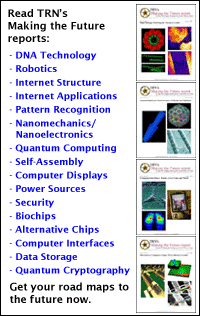
Sturdy quantum computing demoed
By
Eric Smalley,
Technology Research NewsThe quantum states of atoms and subatomic particles that prototype quantum computers use to represent the 1s and 0s of computer information are so fragile that the energy from heat, light and magnetism ordinarily found in their environments is usually enough to change them, effectively stuffing out the information they hold.
Rather than fight the odds, many researchers are working with the environmental noise to create safe havens for quantum bits, or qubits. Particles like atoms, electrons and photons can be used as qubits because they can be oriented in one of two directions -- spin up and spin down. Qubits can also be encoded in the interactions of pairs of particles. The key to making protected qubits is to encode logical qubits in multiple physical qubits.
These approaches are central to efforts aimed at making viable quantum computers, said Jason Ollerenshaw, a researcher at the University of Toronto in Canada. "Techniques for resisting environmental noise will be essential in building quantum computers on a practical scale," he said. Quantum computers hold the promise of solving certain types of problems like cracking secret codes that are far beyond the reach of ordinary computers.
Ollerenshaw and his colleagues at the University of Toronto have built a prototype quantum computer that can execute a quantum search algorithm despite environmental noise. "We have experimentally demonstrated that a quantum computer can be protected from decoherence -- the detrimental effects of environmental noise -- during the course of a complete quantum computation," said Ollerenshaw.
The prototype has just four qubits. Practical quantum computers will require thousands or millions of qubits. "The specific technique we have demonstrated here may be important for the construction of larger computers," said Ollerenshaw.
According to the laws of quantum physics, particles can also be viewed as waves, and interacting pairs of particles have a common waveform. By tuning the way a pair of particles interact with noise in the environment, researchers can create waveforms whose shapes are symmetrical. These symmetrical portions of the waves are unaffected by noise.
These decoherence-free subspaces can be used to make sturdy qubits. "Think of a chessboard in the middle of a game. Some spaces on the board are dangerous. If you move a piece there, it will be open to attack by one of your opponent's pieces. But some spaces are safe; none of your opponent's pieces can attack there," said Ollerenshaw. "Our computer protects its information by keeping it in the safe spaces," he said.
The researchers used decoherence-free subspaces to implement Grover's quantum search algorithm, which finds items in lists using far fewer than steps than it would take to check item by item. The researchers found that the algorithm worked under different levels of noise, and the algorithm failed in the presence of relatively low levels of noise when it was run without decoherence-free subspaces.
The researchers also tested the system using the Deutsch-Jozsa algorithm, a simpler quantum algorithm that performs the equivalent of looking at both sides of a coin at once.
The researchers' computer used the nuclear spins of two carbon atoms, a nitrogen atom, and a hydrogen atom that were all part of a glycine molecule. Millions of copies of the molecule in a test tube were subjected to magnetic pulses as the computer's input and the researchers measured the radio waves emitted by the atomic nuclei to read the computer's output. This is the same nuclear magnetic resonance method used in medical magnetic resonance imaging systems. The quantum search algorithm was implemented by a series of carefully timed magnetic pulses.
Nuclear magnetic resonance is widely considered a dead-end in terms of building practical quantum computers because the system's signal-to-noise ratio is unacceptable for more than about 10 qubits. Nuclear magnetic resonance quantum computers are popular with researchers as testbeds, however. "NMR is an excellent technique for testing new ideas in quantum computing because NMR theory and instrumentation are so well-developed and nuclear spin systems are so well-behaved," said Ollerenshaw.
A similar experiment carried out at about the same time by another team of researchers at the University of Toronto demonstrated the Deutsch-Jozsa algorithm in decoherence-free subspaces implemented in a prototype optical quantum computer that formed two logical qubits from four physical qubits.
Decoherence-free subspaces involve a trade-off. They provide sturdy qubits, but require at least twice as many particles.
The NMR researchers' experiment used artificially induced noise. The next step is to use the same technique to resist naturally occurring decoherence, said Ollerenshaw.
It will be a long time before practical applications of quantum computing are possible, said Ollerenshaw. "Longer than 20 years," he said.
Ollerenshaw's research colleagues were Daniel Lidar and Lewis Kay. The work appeared in the November 21, 2003 issue of Physical Review Letters. The research was funded by The Natural Sciences and Engineering Research Council of Canada (NSERC) and the Defense Advanced Research Projects Agency (DARPA).
Timeline: > 20 years
Funding: Government
TRN Categories: Quantum Computing and Communications; Physics
Story Type: News
Related Elements: Technical paper, "Magnetic Resonance Realization of Decoherence-Free Quantum Computation," Physical Review Letters, November 21, 2003
Advertisements:
April 7/14, 2004
Page One
Net plan builds in search
Robot guided by its voice
Angle speeds plastic transistor
Sturdy quantum computing demoed
Briefs:
DNA folds into paired pyramids
Fiber spun from nanotube smoke
Material boosts thermoelectricity
Nano ribbons coil into rings
Simulation maps nano patterns
Chip-camera combo tracks viruses
News:
Research News Roundup
Research Watch blog
Features:
View from the High Ground Q&A
How It Works
RSS Feeds:
News
Ad links:
Buy an ad link
| Advertisements:
|
 |
Ad links: Clear History
Buy an ad link
|
TRN
Newswire and Headline Feeds for Web sites
|
© Copyright Technology Research News, LLC 2000-2006. All rights reserved.